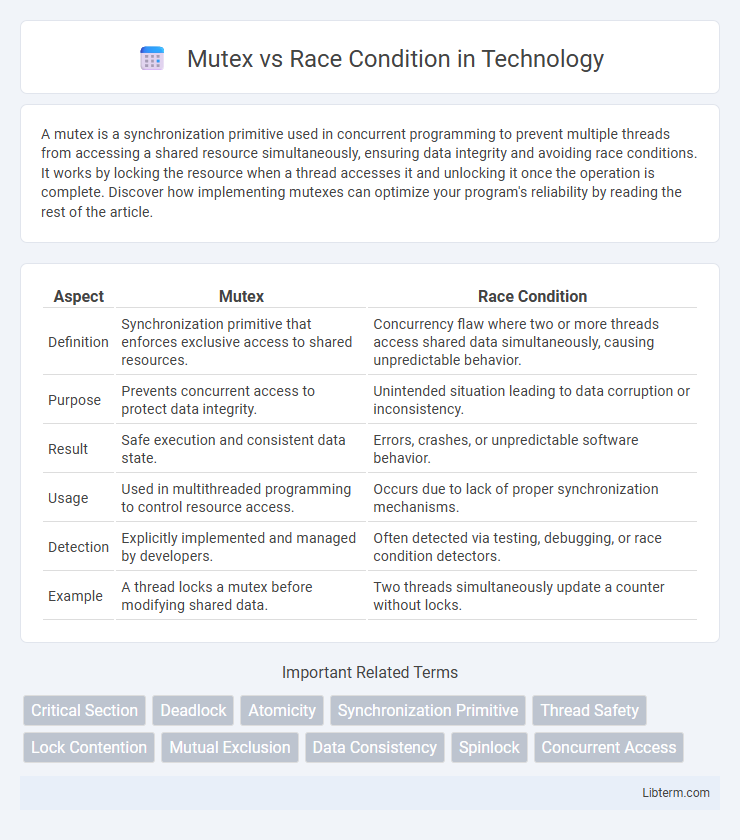A mutex is a synchronization primitive used in concurrent programming to prevent multiple threads from accessing a shared resource simultaneously, ensuring data integrity and avoiding race conditions. It works by locking the resource when a thread accesses it and unlocking it once the operation is complete. Discover how implementing mutexes can optimize your program's reliability by reading the rest of the article.
Table of Comparison
| Aspect | Mutex | Race Condition |
|---|---|---|
| Definition | Synchronization primitive that enforces exclusive access to shared resources. | Concurrency flaw where two or more threads access shared data simultaneously, causing unpredictable behavior. |
| Purpose | Prevents concurrent access to protect data integrity. | Unintended situation leading to data corruption or inconsistency. |
| Result | Safe execution and consistent data state. | Errors, crashes, or unpredictable software behavior. |
| Usage | Used in multithreaded programming to control resource access. | Occurs due to lack of proper synchronization mechanisms. |
| Detection | Explicitly implemented and managed by developers. | Often detected via testing, debugging, or race condition detectors. |
| Example | A thread locks a mutex before modifying shared data. | Two threads simultaneously update a counter without locks. |
Introduction to Concurrency in Programming
Mutex is a synchronization mechanism that enforces exclusive access to shared resources, preventing multiple threads from entering critical sections simultaneously. Race condition occurs when concurrent threads access and modify shared data without proper synchronization, leading to unpredictable and erroneous program behavior. Effective concurrency in programming relies on using mutexes to avoid race conditions and ensure thread-safe operations.
What is a Mutex?
A mutex, or mutual exclusion object, is a synchronization primitive used to prevent race conditions by ensuring that only one thread or process can access a shared resource at a time. It enforces exclusive access to critical sections of code, preventing concurrent modifications that lead to inconsistent or unpredictable behavior. Implementing a mutex guarantees thread-safe operations in multithreaded programming environments by serializing access to shared data.
Defining Race Condition
A race condition occurs when multiple threads or processes access shared data concurrently, and the final outcome depends on the unpredictable timing of their execution. Mutexes are synchronization primitives designed to prevent race conditions by ensuring that only one thread can access critical sections of code at a time. Proper use of mutexes enforces atomicity and consistency, eliminating race conditions in multithreaded environments.
How Mutexes Prevent Race Conditions
Mutexes prevent race conditions by enforcing exclusive access to shared resources, ensuring that only one thread or process can access critical sections of code at a time. This locking mechanism prevents simultaneous modifications that cause inconsistent or unpredictable states in multithreaded environments. By serializing access, mutexes maintain data integrity and synchronization across concurrent executions.
Key Differences: Mutex vs Race Condition
A mutex is a synchronization primitive used to prevent race conditions by ensuring exclusive access to a shared resource in concurrent programming. Race conditions occur when multiple threads access shared data simultaneously without proper synchronization, leading to unpredictable and erroneous outcomes. The key difference is that a mutex is a tool to avoid race conditions, whereas a race condition is the problem caused by unsynchronized concurrent access.
Common Examples in Real-World Applications
A mutex prevents race conditions by ensuring exclusive access to shared resources, commonly seen in database transactions where multiple users update records simultaneously. In contrast, race conditions occur in multithreaded applications such as web servers when threads access and modify shared data without proper synchronization, leading to inconsistent states or crashes. Real-world examples include deadlocks in operating systems and data corruption in financial software when mutexes are not correctly implemented.
Potential Issues with Mutex Usage
Mutexes can lead to potential issues such as deadlocks, where two or more threads wait indefinitely for each other to release locks, resulting in a standstill. Improper or excessive use of mutexes may cause priority inversion, significantly degrading system performance when high-priority threads are blocked by lower-priority ones holding the mutex. Furthermore, mutex contention increases latency and can reduce scalability in multi-threaded applications by causing threads to spend excessive time waiting for locks.
Best Practices for Avoiding Race Conditions
Employing mutexes effectively involves locking shared resources to prevent simultaneous access in concurrent processes, thus avoiding race conditions. Best practices include minimizing the duration of lock holding, using fine-grained locking to reduce contention, and consistently ordering mutex acquisitions to prevent deadlocks. Implementing thread-safe data structures and atomic operations further enhances synchronization and reliability in multithreaded environments.
Mutex Alternatives and Synchronization Tools
Mutex alternatives include spinlocks, semaphores, and read-write locks, each offering varying granularity and performance trade-offs in controlling access to shared resources. Spinlocks are efficient in low-latency scenarios by busy-waiting, while semaphores allow controlling access to multiple instances of a resource. Advanced synchronization tools like condition variables and barriers further facilitate complex thread coordination without the overhead of mutex contention.
Conclusion: Choosing the Right Concurrency Solution
Selecting the appropriate concurrency solution depends on the complexity of the problem and the need for data integrity. Mutexes provide explicit locking mechanisms to prevent race conditions by ensuring exclusive access to shared resources. In scenarios requiring fine-grained control and minimal overhead, mutexes are essential, while for simpler or read-heavy tasks, other synchronization methods might suffice to avoid race conditions.
Mutex Infographic

 libterm.com
libterm.com